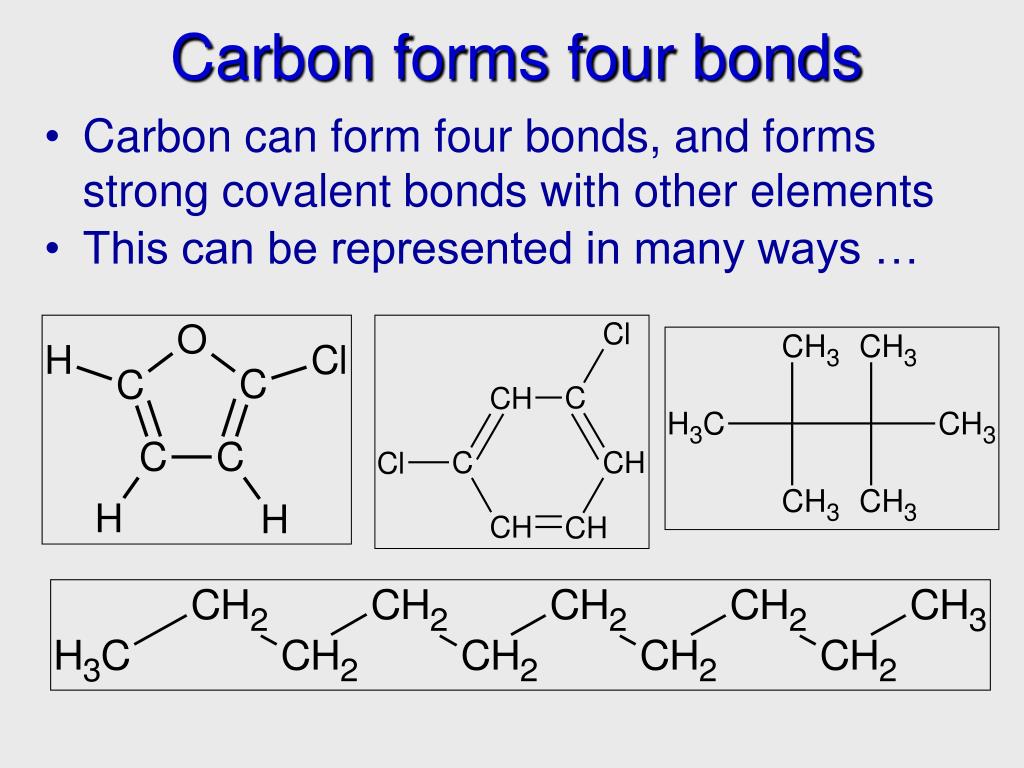How Many Bonds Does Carbon Usually Form
How Many Bonds Does Carbon Usually Form - These four electrons can be gained by forming four covalent bonds, as illustrated here for carbon in ccl 4 (carbon tetrachloride) and silicon in sih. However, to maintain its stability,. How can carbon form 4 bonds? Because carbon has four electrons in its valence (outer) shell, it can form four covalent bonds. Carbon has six valence electrons, which means it can form up to six bonds with other atoms. In a single bond, two carbon. This same method can be used to. Carbon typically makes four bonds because its full valence shell is 8 and its valence number is 4.
Carbon has six valence electrons, which means it can form up to six bonds with other atoms. However, to maintain its stability,. Carbon typically makes four bonds because its full valence shell is 8 and its valence number is 4. In a single bond, two carbon. This same method can be used to. How can carbon form 4 bonds? These four electrons can be gained by forming four covalent bonds, as illustrated here for carbon in ccl 4 (carbon tetrachloride) and silicon in sih. Because carbon has four electrons in its valence (outer) shell, it can form four covalent bonds.
These four electrons can be gained by forming four covalent bonds, as illustrated here for carbon in ccl 4 (carbon tetrachloride) and silicon in sih. How can carbon form 4 bonds? This same method can be used to. Carbon typically makes four bonds because its full valence shell is 8 and its valence number is 4. Because carbon has four electrons in its valence (outer) shell, it can form four covalent bonds. In a single bond, two carbon. Carbon has six valence electrons, which means it can form up to six bonds with other atoms. However, to maintain its stability,.
Why carbon does not form four bonds with another carbon?/chemical
However, to maintain its stability,. These four electrons can be gained by forming four covalent bonds, as illustrated here for carbon in ccl 4 (carbon tetrachloride) and silicon in sih. How can carbon form 4 bonds? In a single bond, two carbon. Carbon has six valence electrons, which means it can form up to six bonds with other atoms.
[Solved] Solve. How many carbonoxygen o bonds are present in the
In a single bond, two carbon. How can carbon form 4 bonds? Carbon typically makes four bonds because its full valence shell is 8 and its valence number is 4. This same method can be used to. Because carbon has four electrons in its valence (outer) shell, it can form four covalent bonds.
PPT Organic Chemistry Functional Groups PowerPoint Presentation
These four electrons can be gained by forming four covalent bonds, as illustrated here for carbon in ccl 4 (carbon tetrachloride) and silicon in sih. Carbon typically makes four bonds because its full valence shell is 8 and its valence number is 4. However, to maintain its stability,. Carbon has six valence electrons, which means it can form up to.
Aluminum Bonding Exploring How Many Bonds It Can Form Aluminum
Carbon typically makes four bonds because its full valence shell is 8 and its valence number is 4. How can carbon form 4 bonds? This same method can be used to. Because carbon has four electrons in its valence (outer) shell, it can form four covalent bonds. Carbon has six valence electrons, which means it can form up to six.
How many bonds can Carbon form?
These four electrons can be gained by forming four covalent bonds, as illustrated here for carbon in ccl 4 (carbon tetrachloride) and silicon in sih. How can carbon form 4 bonds? In a single bond, two carbon. Because carbon has four electrons in its valence (outer) shell, it can form four covalent bonds. Carbon has six valence electrons, which means.
How many bonds does Nitrogen form? YouTube
How can carbon form 4 bonds? Carbon typically makes four bonds because its full valence shell is 8 and its valence number is 4. This same method can be used to. Because carbon has four electrons in its valence (outer) shell, it can form four covalent bonds. These four electrons can be gained by forming four covalent bonds, as illustrated.
[Solved] help me solved practice questions 14 with details
Carbon typically makes four bonds because its full valence shell is 8 and its valence number is 4. How can carbon form 4 bonds? These four electrons can be gained by forming four covalent bonds, as illustrated here for carbon in ccl 4 (carbon tetrachloride) and silicon in sih. This same method can be used to. However, to maintain its.
SOLVEDHow many bonds does carbon normally form? What are the different
However, to maintain its stability,. These four electrons can be gained by forming four covalent bonds, as illustrated here for carbon in ccl 4 (carbon tetrachloride) and silicon in sih. In a single bond, two carbon. How can carbon form 4 bonds? Carbon has six valence electrons, which means it can form up to six bonds with other atoms.
Solved How many bonds does each element usually form with
This same method can be used to. Because carbon has four electrons in its valence (outer) shell, it can form four covalent bonds. How can carbon form 4 bonds? These four electrons can be gained by forming four covalent bonds, as illustrated here for carbon in ccl 4 (carbon tetrachloride) and silicon in sih. Carbon typically makes four bonds because.
How many bonds can carbon form
This same method can be used to. Carbon has six valence electrons, which means it can form up to six bonds with other atoms. Carbon typically makes four bonds because its full valence shell is 8 and its valence number is 4. In a single bond, two carbon. These four electrons can be gained by forming four covalent bonds, as.
How Can Carbon Form 4 Bonds?
In a single bond, two carbon. Carbon typically makes four bonds because its full valence shell is 8 and its valence number is 4. Carbon has six valence electrons, which means it can form up to six bonds with other atoms. However, to maintain its stability,.
These Four Electrons Can Be Gained By Forming Four Covalent Bonds, As Illustrated Here For Carbon In Ccl 4 (Carbon Tetrachloride) And Silicon In Sih.
Because carbon has four electrons in its valence (outer) shell, it can form four covalent bonds. This same method can be used to.





![[Solved] help me solved practice questions 14 with details](https://media.cheggcdn.com/study/c03/c03aba69-465e-42b8-91b5-33e89c4fa2db/image)


